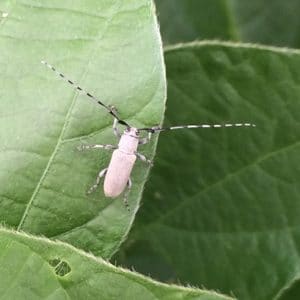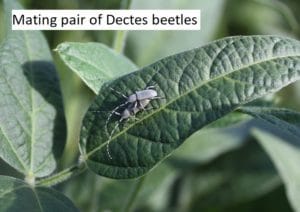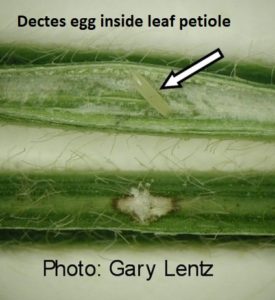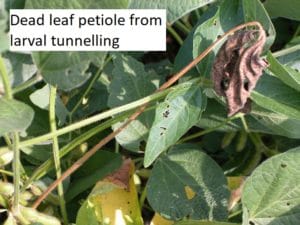 The Dectes stem borer is a long-horned beetle. It is native to the United States east of the Rocky Mountains. Larva tunnel within in the stem of soybean and wild host plants. The adult beetle is gray and approximately 3/8 inch in length. Eggs are yellowish, shiny, elongated and darken to an amber color prior to hatching. The legless larva is creamy white or yellowish with brown mouthparts. It is less than 1/16-inch long when it hatches from the egg but reaches a length of 1/2 to 5/8 inch when full grown. The pupa is yellowish-white, turning to dark brown before the adult emerges. Besides soybean, giant ragweed, sunflower and cocklebur are known hosts. The Dectes stem borer has only one generation annually. Mature larvae overwinter within the stem at the base of infested plants, near or just below the soil level. Pupation occurs in the spring, lasting 10-15 days in Tennessee, with emergence of adults beginning in late June and continuing to August. An adult female can live 4-8 weeks and lay as many as 50 eggs. The female beetle chews a small hole in the leaf petiole, or less commonly in stems, where she lays a single egg. Females prefer to lay eggs in relatively bigger plants, often during bloom (R1 – R3 growth stages). In no-till production areas, it is not uncommon for some soybean fields to have 80% or more infested plants.
The Dectes stem borer is a long-horned beetle. It is native to the United States east of the Rocky Mountains. Larva tunnel within in the stem of soybean and wild host plants. The adult beetle is gray and approximately 3/8 inch in length. Eggs are yellowish, shiny, elongated and darken to an amber color prior to hatching. The legless larva is creamy white or yellowish with brown mouthparts. It is less than 1/16-inch long when it hatches from the egg but reaches a length of 1/2 to 5/8 inch when full grown. The pupa is yellowish-white, turning to dark brown before the adult emerges. Besides soybean, giant ragweed, sunflower and cocklebur are known hosts. The Dectes stem borer has only one generation annually. Mature larvae overwinter within the stem at the base of infested plants, near or just below the soil level. Pupation occurs in the spring, lasting 10-15 days in Tennessee, with emergence of adults beginning in late June and continuing to August. An adult female can live 4-8 weeks and lay as many as 50 eggs. The female beetle chews a small hole in the leaf petiole, or less commonly in stems, where she lays a single egg. Females prefer to lay eggs in relatively bigger plants, often during bloom (R1 – R3 growth stages). In no-till production areas, it is not uncommon for some soybean fields to have 80% or more infested plants.
As it grows, a larva moves from an infested leaf petiole into the main stem where it tunnels within the pith of the main stem until the plant matures. More than one larva may infest a soybean plant, but only one individual survives to maturity. In preparation for overwintering, older larvae girdle the stem from the inside at 2-5 inches above the soil. Tunneling in leaf petioles or in the main stem has little direct effect on yield. However, the girdling behavior can result in lodging, which can cause yield loss, primarily by reducing harvest efficiency. The timing and amount of girdling is unpredictable and often doesn’t result in significant lodging, even in heavily infested fields.
For more information on these pests visit the Fact Sheet (W197)
Dectes beetles are commonly seen when sampling soybean fields and are often caught in sweep nets. The egg stage is small and inserted into leaf petioles, and therefore rarely seen. Likewise, larvae or pupae will not be seen unless leaf petioles or plant stems are ‘split’. Wilted or dead leaves, resulting from larval tunneling in petioles, is a sign of infestation. Girdled plants may be evident near or after harvest, and a larva can often be found inside the stem of a girdled plant during the late fall, winter and spring months.
Treatment with insecticides for Dectes stem borer is not cost effective or recommended. The egg, larval and pupal stages are inside the plant and protected from insecticide applications. It is not practical to control adults because they emerge over a long period of time, live several weeks, and lay many eggs.
Management options
- Harvest heavily infested fields as quickly as possible to minimize potential losses caused by lodging.
- Even light tillage practices can reduce overwintering survival, but because adults are strong fliers and have other weedy hosts, this has little value unless done over a large area.




